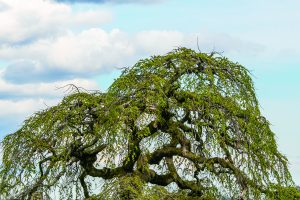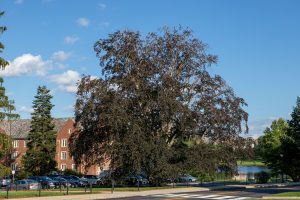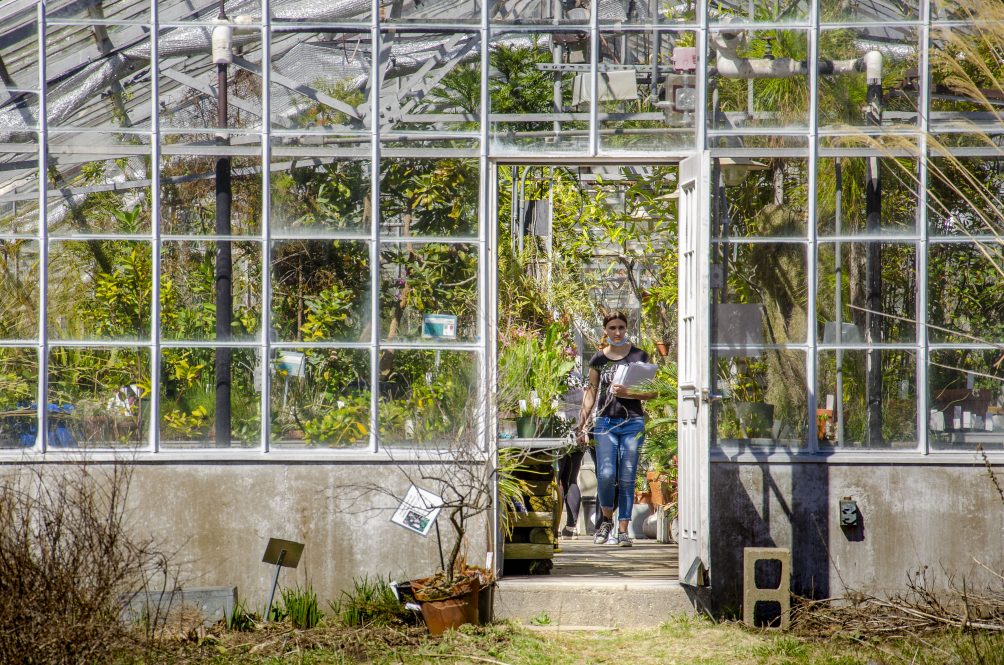For almost as long as recorded time, the simple tree has played a role in the story of humanity.
“We have trees in mythology at the time people believed in multiple gods, and then when people began to worship one god, they continued to think about trees as a character in that narrative and not just objects,” Neda Izadi ’20 MFA says. “It’s very important when we look at history that we recognize humans have always considered the tree very important, essential for life.”
Among the Abrahamic religions, Christians and Jews believe the Tree of Life grew alongside the Tree of the Knowledge of Good and Evil in the Garden of Eden, and for Muslims, the Tree of Immortality stood alone in that garden.
Whatever the belief, it started with a tree.
“It’s very important that we find an element that is similar in all the religious traditions and that one element – it doesn’t matter if you’re Muslim or Jewish or Christian – is the tree,” Izadi says. “The tree is mentioned in all these religions. It’s a unifier.”
And at UConn this semester, a host of programming presented as The Abrahamic Story of the Tree has centered on the importance of the stalky, woody plant, revering it for its dominance in culture, significance in the environment, and beauty in art.

Izadi says she conceived the idea for the series just over a year ago when she worked in the Office of Diversity, Equity, Inclusion, and Justice and pitched the concept to Vice President for Global Affairs Daniel Weiner, who’d asked for ideas on a way to work with Global Affairs’ Abrahamic Programs for Academic Collaboration in the MENA Region.
The Story of the Tree, which had figured into Izadi’s MFA puppetry project, came to mind but not only to connect the faiths. In a world where global warming affects everyone no matter their religion, a singular tree has added value – or at least it should.
As planning began, the number of departments interested in participating grew, Izadi says, drawing, for example, UConn Hillel and the Alexey von Schlippe Gallery at UConn Avery Point with student art exhibitions, Archives & Special Collections with a display of picture books and engravings, and UConn Arboretum with tours of trees around campus.
Students in the After School Academy for English Learners worked with Izadi on a puppetry performance at the Hartford Public Library and the Mansfield Downtown Partnership installed a student art exhibit in Downtown Storrs.
“When we started doing this, I didn’t imagine we would be doing Indonesian puppetry plays at the Ballard Institute and Museum of Puppetry, but that just grew out of Matthew Cohen’s expertise,” says Kathryn Moore, assistant professor of art history who served on the working committee to put together the programming, which includes sold-out performances of puppet arts professor Cohen’s “Ramayana: A Tale of Trees and Wood.”
Many of the programs take advantage of UConn faculty expertise, Moore says, including “Magic and Majesty – The Immortal Tree” exhibition at the William Benton Museum of Art that painting professor Kathryn Myers and her MFA students curated.
However, Texas sculptor Beverly Penn, who casts plant material in bronze, has pieces on display at the Alexey von Schlippe Gallery at UConn Avery Point, Moore says, and work from Australian-Indonesian artist Jumaadi is on display in “Migration of Flora” at the Contemporary Art Galleries in the Fine Arts Complex.
“We knew we wanted to invite scholars and get our own scholarly expertise involved, but we always wanted to be speaking to a general audience,” Moore notes. “We had that goal from the beginning.”
This includes a two-day conference that Moore organized, “The Tree of Life: Interconnecting Religions, Artistic Traditions, and Scientific Knowledge,” on April 27-28, which culminates with a talk by evolutionary biologist Stephen Smith from the University of Michigan. Anyone is invited to join the conference, either in-person or virtually.
Making parts of the series available virtually also was important, Moore says, in part to respond to audience demand post-pandemic but also so they can live online long after the semester wraps and exhibitions are replaced.
“The Tree of Life is inherently about creativity and celebrating nature. Think about what this idea can do to create dialogues between different cultures,” Moore says. “We’re representing the beauty of nature, reflecting on the interconnectedness of nature, and finding connections between cultures that are unexpected.”

Cynthia Jones, professor emeritus and director of UConn Botanical Conservatory, says there were at least a dozen trees mentioned in the Abrahamic texts and six of them are on display in the greenhouses at UConn, including a dwarf pomegranate, olive, and acacia.
While the Story of the Tree series includes many events steeped in art exhibition and performance, tours of the Arboretum and Botanical Conservatory are a way to acknowledge the scientific element and trees’ place in the environment.
“Trees in biblical times were probably very similar to what they are now, if not identical,” Jones says, explaining that a few thousand years is “barely a second” in evolutionary time. This means the palm branches that would have been waved when Jesus entered Jerusalem a week before Easter would look the same as they do today, for instance.
In a practical sense, humans value trees because they provide wood for shelter, food in the form of nuts and fruits, and shade from the sun, Jones says. They’re part of a thin green layer – if all vegetation were compacted over the Earth’s land mass, it would be only about 10 inches deep – and supports all of life on Earth, taking in carbon dioxide, storing energy in the form of sugars, and releasing oxygen.
More than that, they’re also good for mental health, which might be one reason property in Manhattan on a tree-lined street often is more expensive than that a block over without trees, Jones says.
“Trees offer what I think of as the human connection to nature,” she adds. “It might be biophilic, an evolutionary tendency to connect to other living things. It might be that they’re comforting to look at and allow our brain to recover from too much concentration. Trees are really important in the way they affect our emotional health and our sense of wellbeing. You can walk outside and look up into the canopy of a tree and watch the light playing on the leaves for three minutes and feel so much better.”
An online calendar of events happening in conjunction with The Abrahamic Story of the Tree can be found online. The project comes with support from the School of Fine Arts, Humanities Institute, College of Liberal Arts and Sciences, Human Rights Institute, Asian and Asian American Studies Institute, Ballard Institute and Museum of Puppetry, William Benton Museum of Art, UConn Hillel, and the Mansfield Downtown Partnership Abrahamic Programs.



